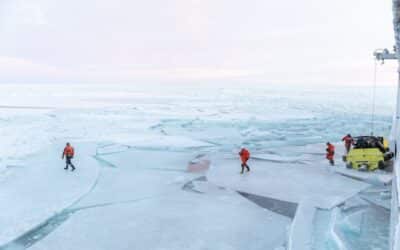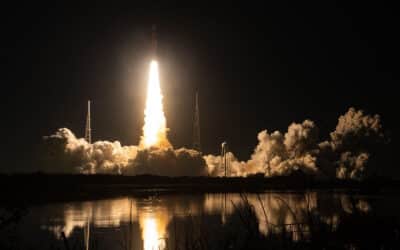» Download this briefing [pdf]
Locations: Near Barrow, Alaska; the Beaufort Gyre (an ocean current flowing past Nunavut and Alaska); and Fram Straight (between Greenland and Svalbard)
Budget: $97,630 (based on 2015 crowdfunder1, which raised $3,103 from 24 donors, but full implementation would cost millions)
Summary:
The Ice 911 project2 proposes to scatter millions of tiny glass bubbles over arctic ice, which would reflect sunlight, slowing the melting process in the summer months. The project’s proponents are pitching the project as a form of “soft geoengineering”, which they claim is less damaging and more reversible than other techniques. Their initial plan is to use their glass bubbles to prevent strategic areas of ice from melting, which could block larger ice sheets in the Arctic Ocean from floating south (where they would melt faster).

Experiments are deploying millions of tiny glass spcheres to reflect sunlight and delay melting of ice.
The effects of a large-scale geoengineering experiment like Ice 911 are difficult to determine. Just like other solar radiation management experiments, Ice 911 would develop infrastructure and technology that aim to change global weather patterns. Reflecting sunlight back into space on a massive scale in the Arctic could have unanticipated changes on precipitation, temperature and humidity all over the globe.
In addition to potentially catastrophic unanticipated effects, anticipated effects could be the most dangerous: the ability to change weather on other parts of the planet could become a powerful weapon wielded by governments or private actors.
Key Players:
Project leader Leslie Field-Barth is an electrical engineer and researcher who has worked for Chevron and various Silicon Valley firms, and currently runs a nanotechnology consultancy. She also teaches at Stanford.
Key dates:
According to the project, Ice 911 has already conducted experiments that covered 17,500 square metres of ice with their glass spheres in 2017 in Alaska.
In 2018, the Ice 911 project intends to cover .25 km of ice with its materials. In 2019, their stated plan is to scale that up by 20x on ice sheets in the Beaufort Gyre or Fram Strait.
Potential Impacts:
Ice 911’s goal is to spread millions of hollow glass beads the size of grains of sand over ice in order to reflect sunlight and slow the melting of ice, blocking the southward flow of larger bodies of ice and preventing those from melting as well. This could affect weather patterns locally and globally, habitat and animal migration in the Arctic, as well as other unanticipated effects,
While increasing the albedo of ice might seem more innocuous than, for example, spraying thousands of tonnes of sulphites into the stratosphere, it could have similar effects on weather patterns if implemented on a large enough scale to have an impact on the climate. Computer models show that “albedo enhancement” and “solar radiation management” (SRM) projects – especially coupled with a continued increase in atmospheric CO2 – could have profound effects on rainfall patterns in vulnerable regions like the Sahel and the Amazon basin, leading to droughts that could affect millions of people and threaten biodiversity.
As such, the same concerns about weaponization that have been raised about other SRM projects apply. Once Ice 911 has been implemented on a large scale, data can be collected about effects on global weather patterns.

Reflecting sunlight back into space on a scale big enough to modify global temperatures would have massive effects on weather patterns, which could lead to weaponization of geoengineering. Computer models suggest that Solar Radiation Management methods like cloud brightening could lead to drought in the Sahel region of Africa or South America. In the likely scenario that SRM creates winners and losers in terms of rainfall or other weather factors, the techniques would inevitably become a tool of geopolitics.
To the extent that Ice 911 is succesful at changing global temperatures, it can become a tool of geopolitical power, with powerful nations claiming that they’re modifying global weather patterns for the good of the planet while they may be putting at risk the sources of food and water for many million peoples in Asia and Africa.
In the Arctic, rapid changes to the pattern of ice floes could impact animal migration as well as local weather patterns. Climate change is already having profound effects in the Arctic, but that doesn’t mean major changes to the circulation of ice and ocean currents would be an improvement. Without significant study, major unanticipated negative impacts could result, affecting conditions for hunting, fishing and trapping in nearby communities, animal habitat, plant growth, and changes to quality of life in settled areas. Indeed, it’s possible that major unanticipated effects could negate the “positive” effects anticipated by the authors of Ice 911.
Another source of unanticipated effects could be the glass bubbles themselves. Ice 911 compares its tiny spheres to sand and claims they are harmless to ingest, but there are key differences: hollow sphere may float, creating unanticipated changes in ocean temperature or photosynthesis of ocean life downcurrent; the highly reflective nature could affect animal behaviors, cause disorientation or be mistaken for food sources; and the spheres may have different effects on soil conditions, plant life or organisms that eat them, or further up in the food chain.
Regulatory Status:
The UN Convention on Biodiversity has passed a moratorium on ocean fertilization (2008) and on geoengineering (2010) that cover experiments like this. However, the US is not a party to the CBD. The UN Environmental Modification Convention (ENMOD) prohibits military use of weather modification technology globally.
The London Convention (the International Maritime Organization body that oversees dumping of wastes at sea) has also banned all ocean-based geongineering.
Under US Federal law (National Weather Modification Policy Act of 1976), any modification of the weather is required to be reported to the National Oceanic and Atmospheric Administration, and the results of research must be made public.

A polar bear on an ice floe in the Fram Straight. Covering ice with millions of tiny glass spheres could have many unanticipated effects on the local food chain, from sea life to whales, bears and Indigenous Inuit communities who depend on hunting. Photo: Creative Commons/Fruchtzwerg’s World
The area around Ukpeaġvik (also known as Barrow) where Ice 911’s 2017 experiment was staged, is owned by the Ukpeaġvik Iñupiat Corporation, whose shareholders are people of Iñupiat descent.
The Beaufort Gyre covers the northernmost part of the Arctic Ocean on the Canadian side, and comes into contact with the area of the Nunavut Land Claim. The Land Claim, signed in 1993, grants regional Inuit organization rights to water, and compensation if the “quality, quantity or flow” of water they depend on is affected by a “project or activity”.
The Fram Straight is located between autonomous Danish territory of Greenland and the Norwegian territory of Svalbard. Both countries are signatories to the UN Convention on Biodiversity.
Action required:
The Ice911 project has been developed under the radar of current applicable regulations, and no critical assessment of its impacts has been made. While the existence and immediate impacts of the project are concern enough, the cumulative and future impacts of a scaled up version require the immediate attention of regulatory bodies and civil society organizations.
Sources:
1. https://www.indiegogo.com/projects/ice911-preserve-arctic-ice-to-slow-climate-change#/
2. http://stormquell.org/
Briefing prepared by ETC Group. etc@etcgroup.org



